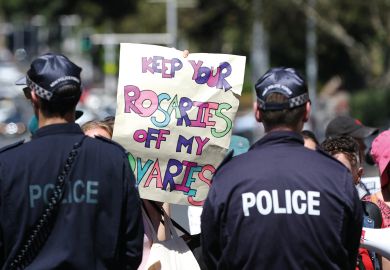Criminology - once a predominantly postgraduate discipline - has, of late, exploded on to the scene at undergraduate level, with many British universities, both old and new, introducing specialist degree courses in criminology and criminal justice.
This seems set to spark some significant shifts in the character and social composition of the discipline. Hitherto, criminology in Britain has comprised a relatively small number of closely connected researchers, working in a limited range of institutions. Criminologists have been emigres from elsewhere - sociology, law, psychology, history - largely self-taught in their adopted field. Criminology teaching was mainly concerned with producing future generations of academic and government researchers.
Now we confront the prospect of a discipline extensive enough to be split between teachers and researchers. We are faced with the job of delivering criminology to increasing numbers of undergraduate students, few of whom are destined to become professional criminologists. And we are required to settle (for practical purposes at least) some contentious matters regarding the scope and boundaries of the discipline.
It is in this context that one must situate the Oxford Handbook of Criminology. This "single comprehensive textbook" sets out "to chart the terrain of criminology". It is designed to fill the gap opened up by the explosion of the subject at undergraduate level and is intended as something criminology courses can be "built around"; an ongoing project, to be revised over the years to reflect the latest developments in the field. And its initial reception suggests it may indeed have a significant impact.
The book's 1,4 pages contain 25 substantive contributions, ranging from victims, drugs and juvenile justice, to white-collar crime, policing and imprisonment. There are comprehensive chapters on the development of criminology, the history of crime and crime control and recent criminological theorising; while contemporary debates around youth, mental illness, race and gender receive prominent coverage. Its authors are well-chosen (if mostly male) and the articles thorough and of high quality. It is, in short, a formidable achievement.
Yet for all its impressiveness, we feel an ambivalence about the overall project. Might it not stifle critical inquiry, fostering the belief that criminology can be "found" in a single text? Why has such a text emerged now and what impact might it have on the future of the discipline?
Two aspects of the text warrant discussion. First, it is worth pointing out that behind a rather bland, textbook-like format some fairly contentious views are being propounded. David Farrington, for example, claims that on the basis of research on human development and criminal careers one can identify chronic offenders at an early age and thereby manage them more effectively. In stark contrast, Geoff Pearson's discussion of youth and crime concludes that young people should be "exempt from prosecution within the criminal law by virtue of their shortage of experience of moral affairs". And we find David Smith making the (long-disputed) claim that the disproportionately high arrest and imprisonment rates of black people in England and Wales are largely a result of the fact that their offending rates exceed those of whites.
There is, of course, no reason why students should not be exposed to such controversy. But it is questionable whether the editors should abdicate responsibility for explaining why these diverse opinions appear in the same book. What sense is the novice student to make of "criminology" without some indication that these are disputed claims, generated from within competing theoretical (not to say political) traditions. Surely something that purports to be a "single comprehensive textbook" cannot so easily sidestep the question of criminological theory? For without such theory a student new to the field is left with little to guide her through the sheer welter of research and commentary with which she is bombarded.
Second, it is noteworthy that the Handbook concentrates almost entirely on what its editors choose to call "British criminology". This focus is most apparent in Paul Rock's somewhat unreflexive chapter on the social organisation of criminology in Britain, where he endeavours to identify the individuals, "networks" and institutions most influential in defining the contours of the discipline. But it permeates the whole text. The authors are drawn exclusively from British universities. And the substantive contributions confine their attention - at the editors' request - to the peculiarities of crime and criminal justice in Britain. Indeed, only Ian Taylor's piece on the political economy of crime and Farrington's aforementioned discussion of criminal careers are convincingly international in scope.
While there is nothing wrong with this singular national focus, it does seem unduly parochial. At a time of increasing globalisation, criminology in Britain needs to be taking more seriously, not only experiences of crime and social regulation in other places, but also the resources of criminological research and reflection that can be found in Europe, North America and beyond. And it ought to be introducing these broader perspectives to its students, few of whom want courses that are merely concerned with Britain.
Many of the Handbook's contributions will become required reading for students, albeit far from the only reading required. However, the appearance of the Handbook raises some pressing questions about the direction of criminological education in Britain. Is there a risk that the welcome expansion of the subject will lead to a narrowing of its scope? Are we fast approaching the publication of the first American-style undergraduate textbook, replete with its instructor's manual and battery of multiple choice questions (each with its one correct answer)?
The Handbook is, of course, nowhere near being such a book and its editors and contributors alike would certainly recoil at any such prospect. But if this project is to continue, its editors need to confront these questions. So here are a few suggestions. We are not seeking a single text (however substantial) that "defines" our courses for us. Nor are we much moved by the notion of a comprehensive overview that sets competing ideas inertly side by side. We prefer to offer students a range of vigorously opinionated views, and expect controversy to play a central role in our teaching. We want criminology students to know the historical antecedents of the ideas that continue, in however murky a way, to animate current criminal justice politics. And theoretical schemes worked out long ago or far away by Kant or Beccaria, Durkheim or Marx can be as crucial to understanding the present as the best-informed review of contemporary British research. Perhaps above all, we want students to be aware that the criminological enterprise addresses itself not just to facts and findings about criminal justice but also to some fundamental questions about order and conflict, freedom and constraint, power and authority. If future editions of the Handbook take account of even some of this, they will be doing criminology an immense service.
Ian Loader and Anne Worrall are both lecturers in the department of criminology, Keele University.
The Oxford Handbook of Criminology
Editor - Mike Maguire, Rod Morgan and Robert Reiner
ISBN - 0 19 876242 9 and 876241 0
Publisher - Oxford University Press
Price - £60.00 and £25.00
Pages - 1,4pp
Register to continue
Why register?
- Registration is free and only takes a moment
- Once registered, you can read 3 articles a month
- Sign up for our newsletter
Subscribe
Or subscribe for unlimited access to:
- Unlimited access to news, views, insights & reviews
- Digital editions
- Digital access to THE’s university and college rankings analysis
Already registered or a current subscriber?



